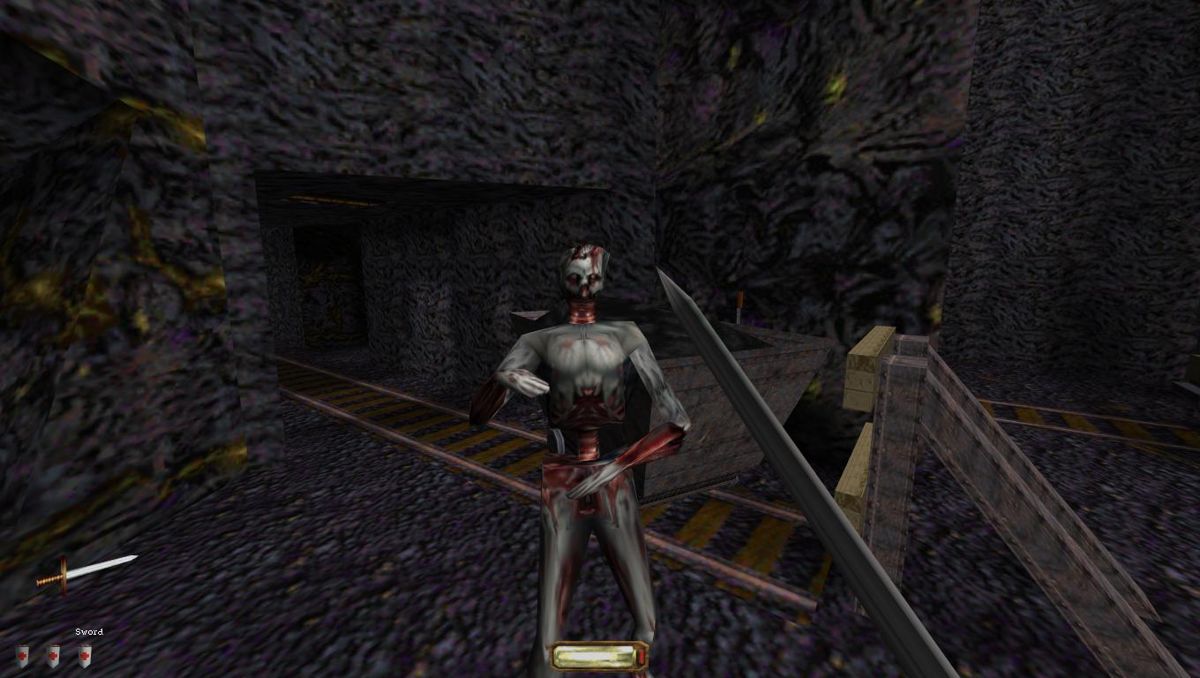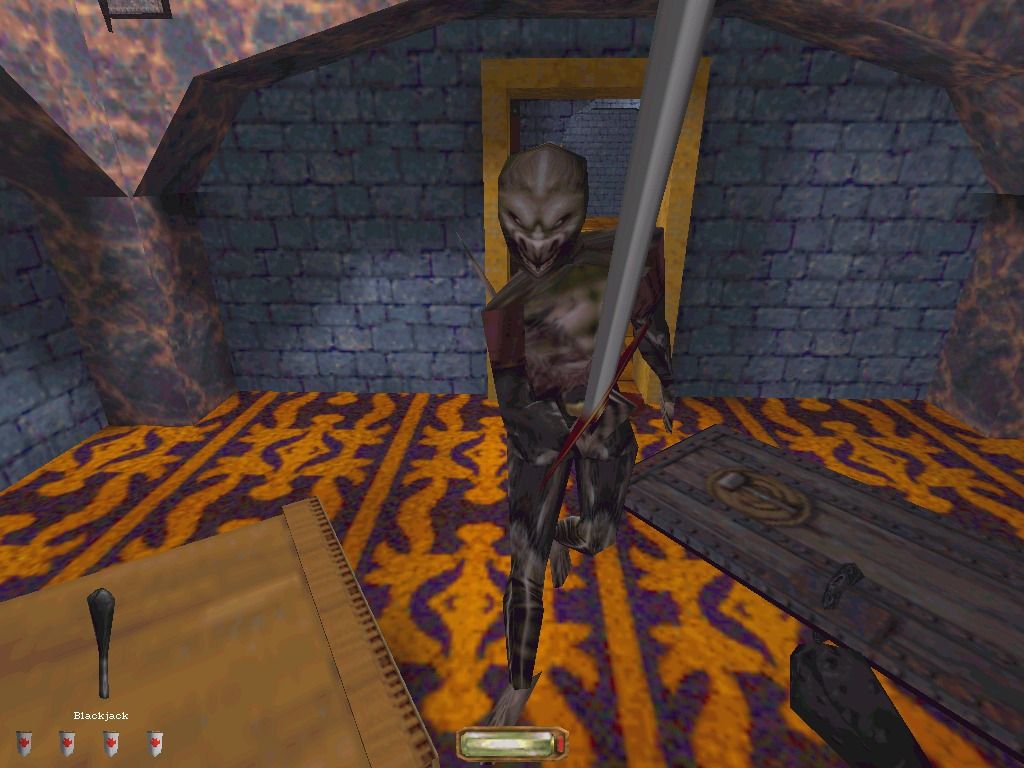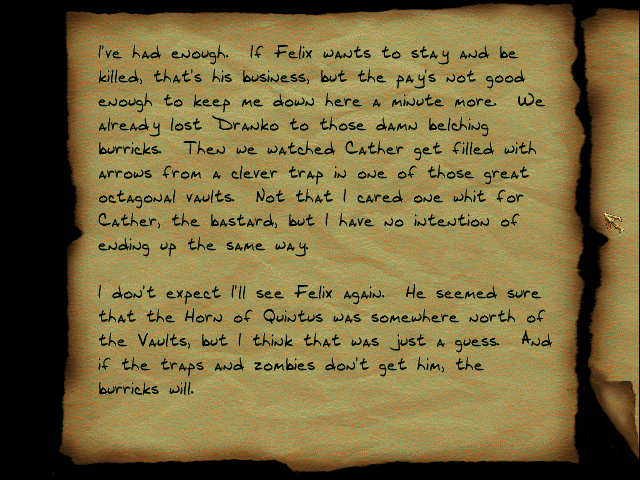There are so many classic sword and sorcery stories centered on thieves - e.g., The Tower of the Elephant, The Tale of Satampra Zeiros, Ill Met in Lankhmar, Liane the Wayfarer, etc. - and Thief: The Dark Project seems to take after them so well, but the funny thing is that in looking over its development history, Thief's final form seems to have been largely an accident.
The player controls a man named Garrett. The game explains in one of its stylish, Nine Inch Nails-esque cutscenes that Garrett was a street urchin who tried to pick the pocket of a man who happened to be part of a secret sect called the Keepers. The man adopted Garrett and had him trained in the ways of the Keepers (the opening tutorial covers this period), but Garrett turned out to be a rebellious and amoral type who struck out for himself, using his skills to become an independent master thief.
The game begins with Garrett pursuing his regular work (i.e., robbing a rich noble's mansion), but as it progresses, Garrett finds himself caught up in a hard-boiled story in which he's hired by shady benefactors to steal accursed prizes and finds himself exploring increasingly weird, sinister environments.
Unlike most games, Thief's story is clearly told and doesn't fall prey to sprawling or becoming overambitious. Garrett does a job, that leads to another job, this job attracts the attention of a femme fatale who offers Garrett a job he might not normally do but he takes it anyway, this leads to yet another job that pulls him even more out of his comfort zone but the pay is too good to turn down (plus, beautiful woman). Double-crosses happen and by the end Garrett is in way over his head against a Pan-like figure called the Trickster God. Everything flows logically until it reaches a logical end. In the right hands, it could reasonably be adapted as a traditional story and not lose much.
One of the lessons Looking Glass learned after creating Ultima Underworld is that, contrary to prevailing wisdom, games become less immersive the more players have to interact with NPCs (humans simply have far more responses to situations than what any game could account for), so when they designed System Shock they made it so that players would never do more than listen to what NPCs were saying and they furthered this in Thief. There are no dialogue trees and no choices to be made. Although Garrett is a relatively distinct character in the sense that he has a certain job and a personality suited to that job, his reactions to story developments are almost entirely kept to the brief cutscenes that set the context for his next mission. He'll make very occasional wry comments on things he sees that don't rock the boat too much ("Looks like these stairs have seen better days"). Otherwise, players are free to find what they encounter as funny or disturbing as they'd like and they're free to react how they'd like within the game's constraints.
What the players will encounter starts out relatively normal, with Garrett being up against armored guards protecting a rich man's house. In the second mission, Garrett has to infiltrate a prison through some mines beneath, but these mines have undead corpses shambling around them. In the next mission, Garrett robs a massive tomb that is crawling with undead - it's this point that the game's sword and sorcery content, the sense of adventure mingling with supernatural horror with a vulnerable hero exploring forbidden territory, is arguably at its strongest. A later mission, in which Garrett is hired to burglarize another mansion, starts out normal enough but as Garrett ascends the floors he's confronted by bizarre sights like twisting hallways, rooms that are upside down, hallways that play tricks on perspective, rooms that open into infinite voids, and tunnels that seem to shrink passersby down to rodent size. It's Lewis Carroll given a very Lovecraftian twist.
There are no expository dumps in the game. After all, why would Garrett, someone who lives there, need someone to explain How It All Works to him? Between bits of conversation, papers and books the player can read, and simply observing how the world works, it's possible to glean that the setting's history involves some kind of calamity that unleashed an undead plague on the world, and that the Hammerites' ascension involved their ability to fight back against these forces and wall off the most afflicted parts of the city. The fact that they're such humorless fanatics possibly is because of the pressures they face in managing this existential threat. But it's mostly down to interpretation.
Oh, right, how does it play? As a thief, it's all about staying out of sight and making as little noise as possible. Like the Shadow himself, Garrett practically vanishes in deep shadows. On soft surfaces, he makes very little noise, but metallic or hard-tiled floors are terrifyingly hard to keep quiet on. To help him along, he's got a Green Arrow-like array of trick arrows he can use, such as arrows with vials of water that somehow can silently douse a blazing torch or arrows that sprout moss to give Garrett an instant carpet to run on silently. Garrett's shadow coverage and detectability are indicated through a very simple icon on the screen. Garrett can kill or club enemies from behind, but if he leaves their bodies lying in the open, guards will become suspicious if they discover them. Garrett does have a sword, but he's no Conan or Gray Mouser in swordsmanship and face-to-face encounters are to avoided if at all possible. Although Thief does show its age in its graphics and some AI limitations of the enemies, it's actually still superior to many modern stealth games, especially in how it uses sound to differentiate surfaces. Another nice feature is in how it handles difficulty - instead of the classic move of giving enemies more health or putting more enemies in a level, kicking up Thief's difficulty simply adds more objectives to your mission list, so you're actually encouraged to explore more thoroughly and see more of what the game has to offer.
The game can be a bit rough in controls. Garrett's mantling ability doesn't always work predictably, and his aim with his blackjack or sword can sometimes be infuriatingly picky (fortunately, enemies don't always notice the weapon fanning through space behind their heads). The physics sometimes mean Garrett hilariously struggles to get up a simple step while crouching. And although most of Thief's game time is absorbing to play, in its later stages it sometimes waffles on its own stealth concept and seems to encourage Garrett to fight and generally do things to which the game engine isn't ideally suited, a problem similar to the Tomb Raider games from the same era. Some missions are just not as good as others. Return to the Cathedral in particular is notorious for going from a white knuckle horror experience to exasperation as players have to constantly double-back over the area to fill a lengthy "Oh, just one more thing..." shopping list for an addle-brained Hammerite ghost.
Thief was very well-received by PC players of the time and despite its age is still today rightfully regarded as a first-rank classic. It spawned a sequel that gained even more acclaim; a second sequel that had a more mixed reception but is still considered to have some very good qualities, especially if its modded; and then a modern reboot by a different studio that most people feel just missed the point.








No comments:
Post a Comment